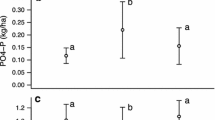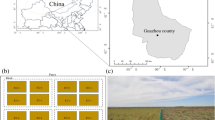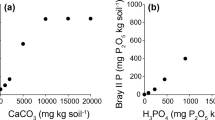Summary
Portions of an annual serpentine grassland community in California are subject to frequent gopher mound formation. Consequently, studies were undertaken to characterize the effects of mound soils on plant growth and ion uptake. For two of the dominant annual species (Bromus mollis L. and Plantago erecta Morris), growth was reduced in gopher mound soil relative to that in inter-mound soil. A similar reduction in growth was found for plants grown in soils collected at a depth corresponding to the depth of gopher burrowing. This reduction in growth was associated with lower total P and N contents of the soil which were reflected in lower shoot contents of N and P. Additional experiments, however, showed that reduced N and P availabilities in mound soil were not entirely responsible for the growth reduction. Similarly, shoot Ca/Mg ratios were reduced in mound soil but additions of Ca improved the Ca/Mg ratio without improving growth. Growth reductions were associated with altered shoot concentrations of microelements, particularly elevated levels of Mn. A competition experiment between Plantago and Bromus showed that Bromus was more competitive than Plantago in mound and inter-mound soils and that soil type had only small affects on the nature of the interaction between the two species.
Similar content being viewed by others
References
Alexander GV, McAnulty LT (1981) Multielement analysis of plant-related tissues and fluids by optical emission spectrometry. J Plant Nutrition 3:51–59
Chew V (1976) Comparing treatment means: a compendium. Hort Science 11:348–357
Davis SD, Mooney HA (1985) Comparative water relations of adjacent California shrub and grassland communities. Oecologia (Berlin) 666:522–529
Ehrlich PR (1965) The population biology of the butterfly, Euphydrias editha. II. The structure of the Jasper Ridge colony. Evolution 19:327–336
Grasmanis VO, Leeper GW (1966) Toxic manganese in near-neutral soils. Plant Soil 25:41–48
Hobbs RJ, Mooney HA (1985) Community and population dynamics of serpentine grassland annuals in relation to gopher disturbance. Oecologia (Berlin) 67:342–351
Jensen WA (1962) Botanical histochemistry. Freeman, San Francisco
Machlis L, Torrey JG (1956) Plants in Action. Freeman, San Francisco
McNaughton SJ (1968) Structure and function in California grasslands. Ecology 49:962–972
Mielke HW (1977) Mound building by pocket gophers (Geomyidae): Their impact on soils and vegetation in North America. J Biogeography 4:171–180
Newman EI (1966) A method of estimating the total length of root in a sample. J Appl Ecol 3:139–145
Proctor J, Woodell SRJ (1975) The ecological of serpentine soils. Adv Ecol Res 9:255–366
Sokal RR, Rohlf FJ (1981) Biometry, Second ed. Freeman, New York
Torsell BWR, Begg JE, Rose CW, Bryne BR (1968) Stand morphology of townsville lucerne (Stylosanthes humilis). Seasonal growth and root development. Aust J Exp Agric Anim Husb 8:533–543
Vlamis J, Jenny H (1948) Calcium deficiency in serpentine soils as revealed by adsorbent technique. Science 107:549
Watanabe FS, Olsen SR (1965) Test of an ascorbic acid method for determining phosphorus in water and NaHCO3 extracts from soil. Soil Sci Soc Proc 29:677–678
Williams PC (1967) Nickel, iron, and manganese in the metabolism of the oat plant. Nature 214:628
Author information
Authors and Affiliations
Rights and permissions
About this article
Cite this article
Koide, R.T., Huenneke, L.F. & Mooney, H.A. Gopher mound soil reduces growth and affects ion uptake of two annual grassland species. Oecologia 72, 284–290 (1987). https://doi.org/10.1007/BF00379280
Received:
Issue Date:
DOI: https://doi.org/10.1007/BF00379280




